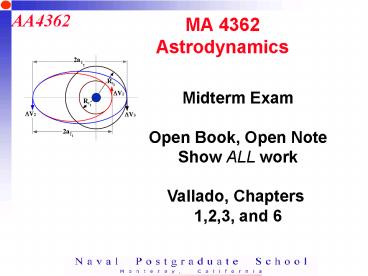MA 4362 Astrodynamics - PowerPoint PPT Presentation
1 / 13
Title:
MA 4362 Astrodynamics
Description:
recently-launched TDRS-I satellite experienced. propulsion (pressurization) ... Is the Mission doomed? Let's find out. Hohmann Transfer Orbit Parameters ... – PowerPoint PPT presentation
Number of Views:41
Avg rating:3.0/5.0
Title: MA 4362 Astrodynamics
1
MA 4362Astrodynamics
Midterm Exam Open Book, Open Note Show ALL
work Vallado, Chapters 1,2,3, and 6
2
First TDRS-IMission Failure
TDRS-I
21 March 2002 TDRS-I Stranded in Useless
Orbit Editor's note Sources tell NASA Watch
that the recently-launched TDRS-I satellite
experienced propulsion (pressurization) problems
during its movement up to GEO. The current
predicament leaves the satellite stranded in a
useless orbit. The satellites current orbit
apogee is 35,800 kilometers (22,236 miles) and
the perigee is approximately 8,000 kilometers
(4,970 miles). The satellite is still in its
launch inclination of 28.5?
RS-68
Delta IV
3
First TDRS-IMission Failure (contd)
TDRS-I
Boeing is working diligently on raising the
orbit of the satellite to Geo-stationary
altitude However, the total DV of the
upper-stage apogee-kick-motor is limited to only
2.4 km/sec Preliminary analyses says that the
total DV required To reach an equatorial
geo-synchronous (geo-stationary) Orbit, exceeds
the capacity of the upper-stage motor Is the
Mission doomed? Lets find out
RS-68
Delta IV
4
Hohmann Transfer Orbit Parameters
Compute semi-major Axis and Eccentricity of
Initial and Hohmann Transfer orbits Compute
Required DV1, DV2, DVtotal to put satellite Into
Geo-synchronous (28.5?) orbit
m 3.986 x 105 km3/sec2
5
Plane Change to Geo-Stationary (0?) Orbit
In order for the TDRS-I spacecraft to be
useful, it must be placed into a geo-stationary
(0????????????) orbit As we will derive later
in the class, the required DV for this simple
plane change is Is it cheaper in terms of
fuel to change planes before or after the DV1?,
the DV2 burn? (Consider ONLY simple plane change)
Why? Evaluate the minimum required DV for a
simple plane Change (Di 28.5 ?) can the
satellite be rescued with a Hohmann Transfer to
GEO?
Space craft velocity at time of plane change
6
Bi-Elliptic Lunar-Assist Rescue Mission
Lets try a different Approach Use
lunar gravity assist to rescue Spacecraft
Perform Plane change In Lunar Vicinity via
gravity assist
Well learn more about This later when we study
Three-body problems
Lunar orbit is inclined at -10.3? to earths
equator
7
Lunar Assist
Well learn more about This later when we study
Three-body problems
Earth Only
Earth / Moon Combined
Lunar Sphere of Influence
8
Bi-Elliptic Orbit Parameters
Do we want to Rendezvous with the moon at
apogee or perigee? Why?
9
Bi-Elliptic Orbit Parameters (contd)
Compute aT1 eT1 -gt Lunar trajectory
semi-major axis , eccentricity aT2 eT2 -gtEarth
return trajectory semi-major axis , eccentricity
10
Bi-Elliptic Orbit Parameters (contd)
Compute DV1 -gt Velocity change required to
insert TDRS into Lunar transfer orbit DV2 -gt
Velocity change required by gravity assist to get
onto proper Earth-return
trajectory ?DV3 -gt Velocity change required to
circularize final orbit at GEO altitude
11
Plane Change to Geo-Stationary (0?) Orbit
In order for the TDRS-I spacecraft to be
useful, it must be placed into a geo-stationary
(0????????????) orbit What is the minimum DV
required for this plane change? (Consider ONLY
simple plane change assume that you can do this
using gravity Assist . But only calculate the
required magnitude not how you do it)
Di 28.5?
Space craft velocity at time of plane change
DVplane change is free because its via
gravity assist
Lunar orbit is inclined at -10.3? to earths
equator
We can Exploit this -10.3? to give the plane
change but we wont do it here
12
Plane Change Schematic
Moon
13
Finally,Compare Total DV requiredfor Hohmann
Transferto DV Required for Bi-EllipticLunar
Gravity Assist Transfer
Assume that DV due to Gravity Assist is
Free .. I.e. dont count it Can the
Satellite be rescued at all? If so, how long will
it take for one full (round-trip) lunar transfer
(assume all burns happen impulsively)































